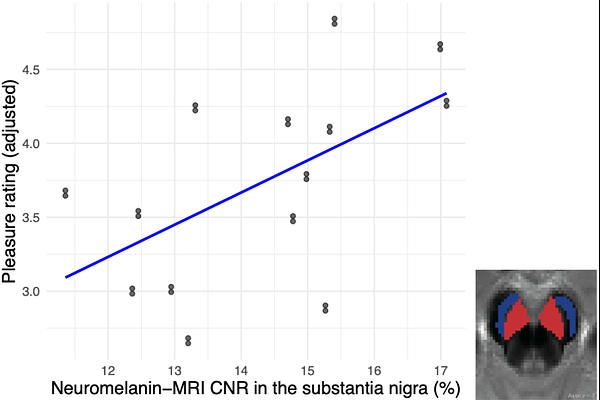Pleasure in groove is associated with neuromelanin levels in the substantia nigra of younger healthy individuals: A neuromelanin-sensitive MRI study

Pleasure in groove is associated with neuromelanin levels in the substantia nigra of younger healthy individuals: A neuromelanin-sensitive MRI study
Etani, T.; Nakajima, S.; Honda, S.; Homma, S.; Kaneko, Y.; Kondoh, S.; Tarumi, R.; Tsugawa, S.; Moriyama, S.; Tobari, Y.; Samma, T.; Horga, G.; Cassidy, C.; Uchida, H.; Fujii, S.
AbstractThe pleasurable urge to move in response to music is called groove. Prior research has suggested a potential link between groove and dopamine function; however, no studies to date have directly investigated the relationship between the two. Here, we aimed to assess individual dopamine function in the substantia nigra of healthy individuals using neuromelanin-sensitive magnetic resonance imaging (NM-MRI), a non-invasive method associated with dopamine function, and to investigate the relationship between the individual dopamine proxy index and sensitivity to the groove experience. In this study, 15 younger (< 48 years) and 16 older ([greater double equals]48 years) healthy individuals participated. Participants listened to ten musical excerpts and rated the groove experience based on \"pleasure\" and \"wanting to move.\" To assess whether the groove experience is related to NM levels, type of musical excerpts, and sex, we analyzed with linear mixed-effects regression models. The results showed that higher NM levels and males were associated with higher pleasure ratings in the younger group. In the \"urge to move\" ratings, type of musical excerpts was associated with ratings in both groups, with previous research revealing higher ratings for musical excerpts with higher groove ratings (Janata et al., 2012). Taken together, these results suggest that the \"pleasure\" aspect of the groove experience in younger individuals was related to dopamine levels in the SN, but may not be associated with the \"urge to move\". Thus, pleasure and the urge to move are likely to involve distinct dopaminergic pathways and mechanisms, warranting further investigation in this regard.